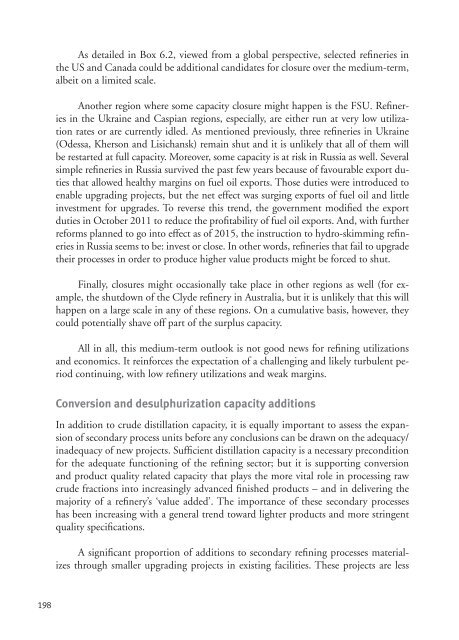World Oil Outlook - Opec
World Oil Outlook - Opec
World Oil Outlook - Opec
- TAGS
- world
- outlook
- opec
- www.opec.org
Create successful ePaper yourself
Turn your PDF publications into a flip-book with our unique Google optimized e-Paper software.
198<br />
As detailed in Box 6.2, viewed from a global perspective, selected refineries in<br />
the US and Canada could be additional candidates for closure over the medium-term,<br />
albeit on a limited scale.<br />
Another region where some capacity closure might happen is the FSU. Refineries<br />
in the Ukraine and Caspian regions, especially, are either run at very low utilization<br />
rates or are currently idled. As mentioned previously, three refineries in Ukraine<br />
(Odessa, Kherson and Lisichansk) remain shut and it is unlikely that all of them will<br />
be restarted at full capacity. Moreover, some capacity is at risk in Russia as well. Several<br />
simple refineries in Russia survived the past few years because of favourable export duties<br />
that allowed healthy margins on fuel oil exports. Those duties were introduced to<br />
enable upgrading projects, but the net effect was surging exports of fuel oil and little<br />
investment for upgrades. To reverse this trend, the government modified the export<br />
duties in October 2011 to reduce the profitability of fuel oil exports. And, with further<br />
reforms planned to go into effect as of 2015, the instruction to hydro-skimming refineries<br />
in Russia seems to be: invest or close. In other words, refineries that fail to upgrade<br />
their processes in order to produce higher value products might be forced to shut.<br />
Finally, closures might occasionally take place in other regions as well (for example,<br />
the shutdown of the Clyde refinery in Australia, but it is unlikely that this will<br />
happen on a large scale in any of these regions. On a cumulative basis, however, they<br />
could potentially shave off part of the surplus capacity.<br />
All in all, this medium-term outlook is not good news for refining utilizations<br />
and economics. It reinforces the expectation of a challenging and likely turbulent period<br />
continuing, with low refinery utilizations and weak margins.<br />
Conversion and desulphurization capacity additions<br />
In addition to crude distillation capacity, it is equally important to assess the expansion<br />
of secondary process units before any conclusions can be drawn on the adequacy/<br />
inadequacy of new projects. Sufficient distillation capacity is a necessary precondition<br />
for the adequate functioning of the refining sector; but it is supporting conversion<br />
and product quality related capacity that plays the more vital role in processing raw<br />
crude fractions into increasingly advanced finished products – and in delivering the<br />
majority of a refinery’s ‘value added’. The importance of these secondary processes<br />
has been increasing with a general trend toward lighter products and more stringent<br />
quality specifications.<br />
A significant proportion of additions to secondary refining processes materializes<br />
through smaller upgrading projects in existing facilities. These projects are less
















